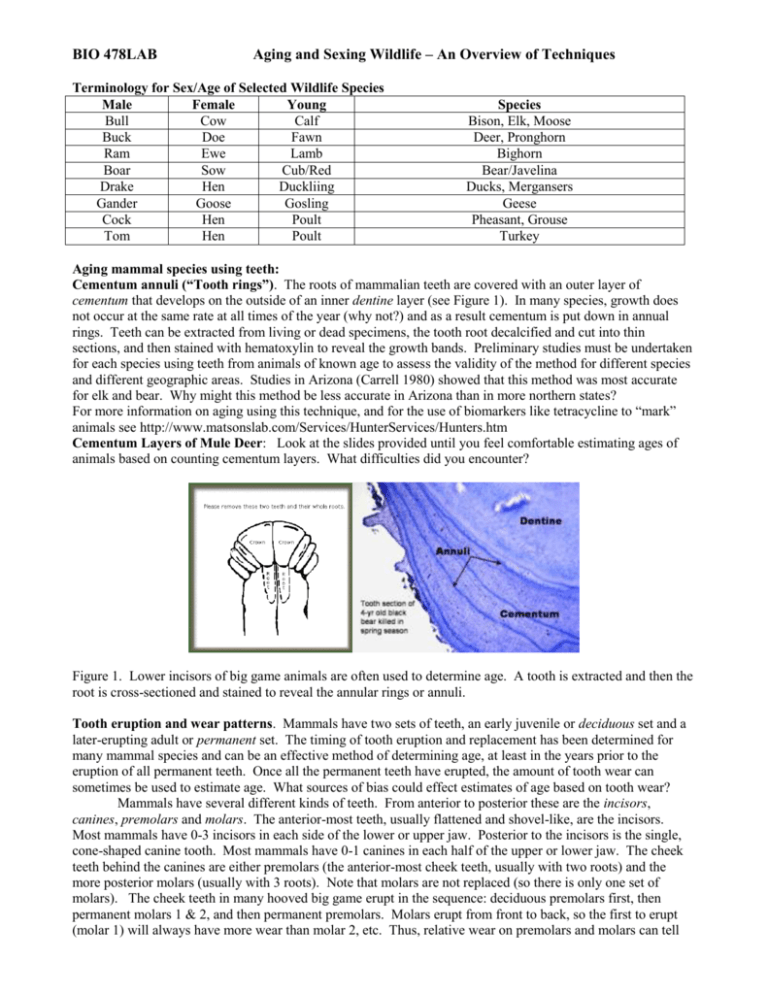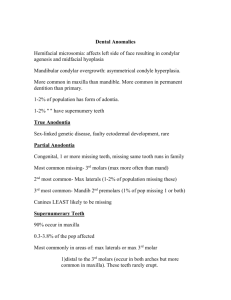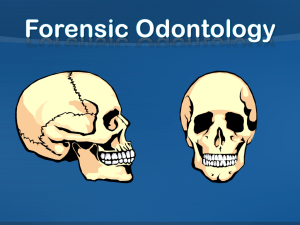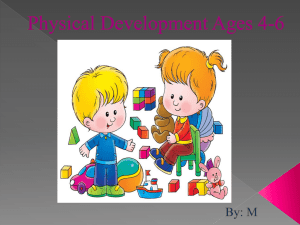Aging and Sexing Wildlife Lab
advertisement

BIO 478LAB Aging and Sexing Wildlife – An Overview of Techniques Terminology for Sex/Age of Selected Wildlife Species Male Female Young Bull Cow Calf Buck Doe Fawn Ram Ewe Lamb Boar Sow Cub/Red Drake Hen Duckliing Gander Goose Gosling Cock Hen Poult Tom Hen Poult Species Bison, Elk, Moose Deer, Pronghorn Bighorn Bear/Javelina Ducks, Mergansers Geese Pheasant, Grouse Turkey Aging mammal species using teeth: Cementum annuli (“Tooth rings”). The roots of mammalian teeth are covered with an outer layer of cementum that develops on the outside of an inner dentine layer (see Figure 1). In many species, growth does not occur at the same rate at all times of the year (why not?) and as a result cementum is put down in annual rings. Teeth can be extracted from living or dead specimens, the tooth root decalcified and cut into thin sections, and then stained with hematoxylin to reveal the growth bands. Preliminary studies must be undertaken for each species using teeth from animals of known age to assess the validity of the method for different species and different geographic areas. Studies in Arizona (Carrell 1980) showed that this method was most accurate for elk and bear. Why might this method be less accurate in Arizona than in more northern states? For more information on aging using this technique, and for the use of biomarkers like tetracycline to “mark” animals see http://www.matsonslab.com/Services/HunterServices/Hunters.htm Cementum Layers of Mule Deer: Look at the slides provided until you feel comfortable estimating ages of animals based on counting cementum layers. What difficulties did you encounter? Figure 1. Lower incisors of big game animals are often used to determine age. A tooth is extracted and then the root is cross-sectioned and stained to reveal the annular rings or annuli. Tooth eruption and wear patterns. Mammals have two sets of teeth, an early juvenile or deciduous set and a later-erupting adult or permanent set. The timing of tooth eruption and replacement has been determined for many mammal species and can be an effective method of determining age, at least in the years prior to the eruption of all permanent teeth. Once all the permanent teeth have erupted, the amount of tooth wear can sometimes be used to estimate age. What sources of bias could effect estimates of age based on tooth wear? Mammals have several different kinds of teeth. From anterior to posterior these are the incisors, canines, premolars and molars. The anterior-most teeth, usually flattened and shovel-like, are the incisors. Most mammals have 0-3 incisors in each side of the lower or upper jaw. Posterior to the incisors is the single, cone-shaped canine tooth. Most mammals have 0-1 canines in each half of the upper or lower jaw. The cheek teeth behind the canines are either premolars (the anterior-most cheek teeth, usually with two roots) and the more posterior molars (usually with 3 roots). Note that molars are not replaced (so there is only one set of molars). The cheek teeth in many hooved big game erupt in the sequence: deciduous premolars first, then permanent molars 1 & 2, and then permanent premolars. Molars erupt from front to back, so the first to erupt (molar 1) will always have more wear than molar 2, etc. Thus, relative wear on premolars and molars can tell you much about the age of the animal. Note that the third deciduous premolar is usually 3-cusped, while all other premolars and molars are two-cusped, so you can always tell an animal with deciduous premolars. Fig 2. The jaw of a one-year old deer on the left and a 5 year old deer on the right. The teeth numbered 1-3 are premolars, 4-6 are the molars. Note that the 3rd permanent premolar and the 3rd permanent molar are both erupting in the one year old. All permanent teeth are present in the 5 year old. Its age would be estimated by tooth wear. Use the Table below to estimate the ages of the elk and javelina jaws provided and use the tooth wear diagram to age the mule deer jaws. Tooth eruption patterns in Elk (Quimby and Gaab 1952) D=Deciduous, P =permanent, () indicates erupting Age (yr) 0.5 1.5 2.5 3.5 Incisors 1 D P P P P P 2 D DP P P P P Canine 3 D D P P P P 1 D D P P P P Premolars 1 D D D (P) P P 2 D D D (P) P P Molars 3 D D D (P) P P 1 (P) P P P P P 2 3 (P) P P P P (P) (P) (P) P Tooth eruption patterns in Javelina (Kirkpatrick and Sowls 1962) Age (months) 2-6 7-10 11-12 13-18 19-21 >21 Incisors 1 D D D D D D 2 D D D D D P Canine 3 D D D D D P 1 D D P P P P Premolars 1 D D D D D P 2 D D D D D P Molars 3 D D D D D P 1 (P) P P P P P 2 3 P P P (P) P Aging selected game bird species using wings. This method requires using characteristics of specific feathers on the wing. Refer to the diagram of wing feathers for their names. Primaries are labeled from the inside-out, so the last two primaries are 9 and 10. Aging Mourning Doves: Full adult plumage is reached in 5-6 mos. Immature: At least one white or buff tipped primary covert OR. Primary coverts gray, but primaries 9 and 10 have smooth white edge. Mature: Primary coverts gray but primaries 9 and 10 are worn and frayed Unknown: Primary coverts gray but all primaries are newly replaced Aging gallinaceous birds: Primaries are replaced from inside to outside and primaries 9 & 10 are not replaced until after the first breeding season. As a result, juveniles will have pointed, worn primaries 9 &10. Gambel’s Quail example: Immatures: Pointed buff-tipped greater primary coverts and pointed primaries 9 & 10 Adult: Rounded gray greater primary coverts and primaries 9 & 10 rounded Sexing waterfowl: Hens can often be distinguished from drakes by the more cryptic coloration of the coverts, often rimmed with light brown to give an overall mottled effect. Some species can be told by other characters. Green-winged Teal example: Male: Stripe on distal tertial distinct and black…. Female: Stripe on distal tertial brown, fading to feather color Aging Wildlife Exercise Place your estimate of the age of the animals presented in lab next to the appropriate label. Have me check this before you leave lab. You need to get a 70% or higher or I won’t let you leave!! Good luck! Bighorn B1 _____ Elk E1 ______ E2 ______ E3 ______ E4 ______ E5 ______ Deer D1 _____ D2 _____ D3 _____ D4 _____ D5 _____ Pronghorn P1 ____ P2 ____ P3 _____ Javelina Place the 4 jaws in order from youngest to oldest Youngest = ____ _____ _____ _____ = oldest BIO478 Lab Aging Wildlife Exercise Name ______________________ Quail Management Sort the box of quail wings to determine the ratio of adults (AHY) to juveniles (HY) Number of AHY = ________ Number of HY = _________ Total = _____ (1pt) % adult _______ % Juvenile __________ 1) Assume (and it’s a big assumption) that this is a representative sample of the population. Name one major reason it might not be (2pts): 2) If mean reproductive success for quail is 2 young/adult, was this past year’s reproduction above or below normal? (1pt) 3) Gambel’s quail are very similar to California quail. Based on evidence in your text for California quail, what environmental factor(s) could have accounted for this (& give the literature reference this is based on!)? (3pts) Mourning Dove Management Sort the box of mourning dove wings to determine the ratio of adults (AHY) to juveniles (HY) Number of AHY = ________ Number of HY = _________ Total = _____ (1pts) % adult _______ % Juvenile __________ 1) If both age classes have equal probability of being killed by hunters, what was the reproductive success during the past spring and summer (# young/adult) of 2003? (1pts) Management Goal: Maintain a pre-hunt dove population of 5 million birds Given: 1) Based on dove call surveys before the 2003 hunt, dove numbers were estimated at 5 million birds 2) An estimated 1 million birds were killed in the 2003 fall dove season. 3) Mean annual survival for mourning doves based on leg band returns has been estimated at 40% for adults (AHY) and 30% for juveniles (HY). 2) Assume reproductive success will be the same in the coming year (2004) as it was during 2003. If hunting mortality is completely compensatory, what will the population of dove be in 2004 before the hunt? (3pts) 3) If hunting mortality is completely additive, what do you estimate the pre-hunt population to be in 2004? (3pts) 4) If hunting mortality is additive, but it results in compensatory recruitment, what do you predict about A) reproduction in summer 2004 and B) your estimate of the 2004 pre-hunt population? (3pts)







